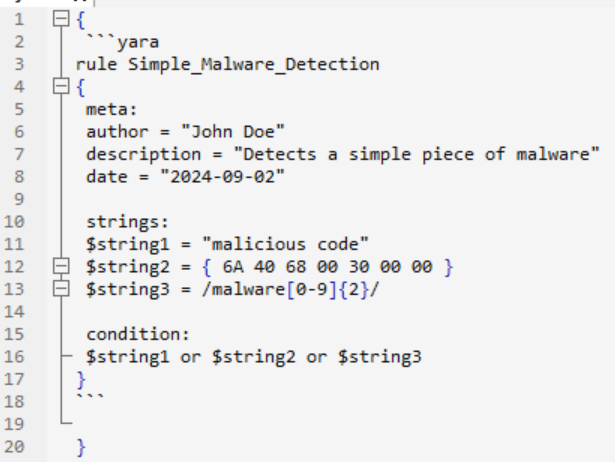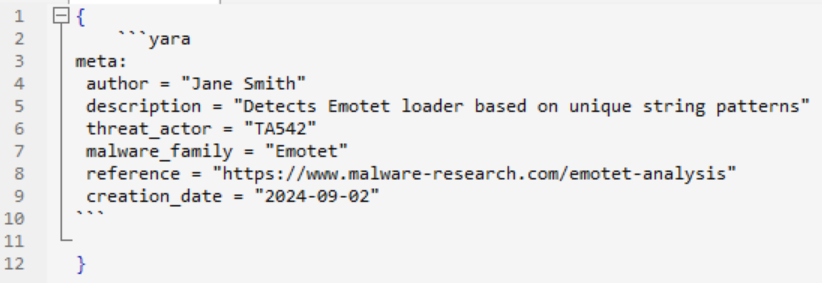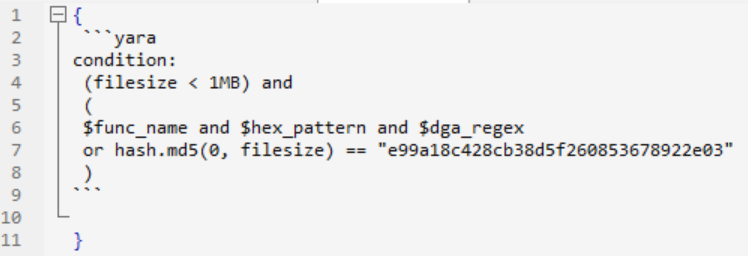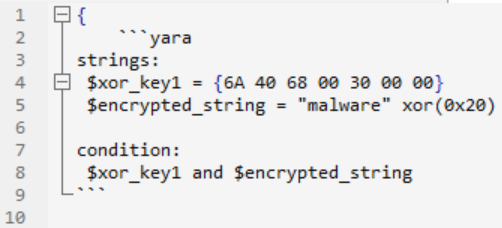In the ever-evolving landscape of cybersecurity, threat hunting has become an indispensable practice for identifying and mitigating advanced threats that often bypass traditional detection mechanisms. Among the various tools and techniques available to cybersecurity professionals, YARA (Yet Another Recursive Acronym) has emerged as a powerful and flexible tool for crafting signatures that can detect, classify, and analyze malware based on specific patterns and characteristics.
This column provides a comprehensive guide to writing effective YARA rules for threat hunting. We will delve into the fundamentals of YARA, explore advanced techniques for crafting precise signatures, and discuss best practices for deploying these rules in real-world scenarios. By the end, you’ll have a deep understanding of how YARA rules can significantly enhance your threat-hunting capabilities, enabling you to detect and respond to sophisticated malware threats.
Understanding YARA: The Foundation of Signature-Based Threat Hunting
YARA is a versatile tool used primarily in malware research and detection. It allows cybersecurity professionals to define rules that identify patterns or signatures within files, processes, or network traffic. These patterns can be as simple as a string of text or as complex as a combination of byte sequences, regex patterns, and logical conditions.
At its core, a YARA rule consists of three main components:
1. Meta Section: Provides metadata about the rule, such as the author, description, and references. While this section doesn’t affect the rule’s functionality, it’s essential for maintaining organized and well-documented rules. Metadata is particularly valuable in large-scale operations where rules are shared across teams and must be understood and maintained over time.
2. Strings Section: Defines the patterns or strings that the rule is looking for within a target file or process. These can include text strings, hexadecimal sequences, and regular expressions. YARA supports various modifiers that refine how these strings are matched, such as nocase (case-insensitive matching) or wide (matching UTF-16 encoded strings). The flexibility in defining strings allows YARA to adapt to various forms of malware obfuscation.
3. Condition Section: The logical expression that determines whether a rule matches a file or process. This section typically references the strings defined earlier, using Boolean operators to create complex matching conditions. Conditions can range from simple checks (e.g., “if this string is present”) to intricate combinations of multiple strings and logical conditions that reflect the malware’s specific characteristics.
Here’s a basic example of a YARA rule:

This rule looks for a specific text string (`$string1`), a hexadecimal pattern (`$string2`), or a regex pattern (`$string3`). If any of these are found, the rule is triggered. This simplicity makes YARA an accessible yet powerful tool for both beginners and seasoned cybersecurity experts.
Crafting Effective YARA Rules: Advanced Techniques and Best Practices
To maximize the effectiveness of YARA in threat hunting, it’s crucial to go beyond basic rules and employ advanced techniques that target specific malware characteristics. Here are some key strategies:
1. Utilize Rich Metadata for Contextual Awareness
While the metadata section doesn’t directly affect detection, it plays a critical role in organizing and maintaining a large rule set. When crafting YARA rules, include comprehensive metadata that provides context about the rule’s purpose, its scope, and the threat actor or malware family it targets. This metadata not only aids in rule management but also helps in correlating detections with threat intelligence.

By including fields such as threat_actor and malware_family, you create a direct link between the YARA rule and the broader threat landscape. This linkage is invaluable in incident response, where understanding the context of a detection can influence remediation strategies.
- Incorporate Multiple String Types for Comprehensive Detection
YARA’s flexibility allows for the use of various string types, including plain text, hexadecimal, and regular expressions. Combining these within a single rule can significantly improve detection accuracy by covering different aspects of the malware’s structure.
– Plain Text Strings: Useful for detecting specific function names, error messages, or unique identifiers within the malware. For example, targeting specific API calls that a malware sample is known to use.
– Hexadecimal Patterns: Ideal for detecting binary sequences that are characteristic of certain malware families, such as unique opcode sequences or file headers. These patterns are particularly useful in detecting packed or encrypted payloads that may not contain easily recognizable text strings.
– Regular Expressions: Powerful for identifying patterns that may vary slightly across different samples, such as domain generation algorithms (DGA) or polymorphic code. Regex allows for flexible matching, which is crucial in identifying threats that evolve rapidly.

This combination of strings ensures that the rule is robust enough to detect the malware even if it employs slight variations to evade detection.
For instance, $hex_pattern could represent a specific sequence of instructions commonly used by a malware family, making it a strong indicator of compromise when combined with other strings.
- Optimize Conditions for Precision and Performance
The condition section is where the real power of YARA lies. Crafting precise conditions requires a deep understanding of the malware’s behavior and structure. Here are some tips:
– Boolean Logic: Combine multiple strings using Boolean operators (AND, OR, NOT) to create nuanced conditions that reduce false positives and focus on specific malware characteristics. For instance, using AND to require the presence of multiple unique indicators that together strongly suggest malicious behavior.
– File Size Checks: Incorporate file size checks to ensure the rule only applies to relevant files. This can improve performance by avoiding unnecessary scans of files that are unlikely to contain the malware. For example, some malware is known to use large or very small files; incorporating a size check can help target the rule more effectively.
– Hash Matching: Use YARA’s built-in hash functions (e.g., hash.md5(), hash.sha256()) to match specific file hashes if the malware sample is known and you want to identify exact copies. This is particularly useful in identifying specific versions of malware that may have been used in previous attacks.

This condition ensures that the rule is both precise and efficient, focusing only on files that meet specific criteria, such as size and the presence of multiple threat indicators. This approach minimizes false positives while ensuring that true threats are not overlooked.
- Handle Obfuscation and Encryption Techniques
Advanced malware often employs obfuscation or encryption to evade detection. YARA rules can counter these techniques by focusing on the patterns that remain consistent despite the malware’s efforts to hide.
– Deobfuscation: Identify and target common deobfuscation routines within the malware. For example, detect the presence of decryption loops or key generation functions. These routines are often less obfuscated than the rest of the code, making them easier to identify.
– Partial Matches: Use YARA’s matches keyword to detect portions of a string or pattern that might remain consistent even if other parts have been obfuscated. This is useful when dealing with polymorphic malware that changes its appearance with each infection but retains core functionality.
– XOR Encrypted Strings: Many malware samples use simple XOR encryption to hide strings. YARA can detect these by applying known XOR keys to search for the decrypted strings. By identifying the encryption routine, you can target the underlying malicious code rather than its obfuscated form.

This example demonstrates how YARA can be used to detect encrypted strings by applying known decryption keys, effectively bypassing the malware’s obfuscation techniques.
This approach is critical in identifying sophisticated threats that use encryption to evade detection.
- Testing and Validation: Ensuring Accuracy and Reliability
Writing YARA rules is only half the battle; ensuring their accuracy and reliability is equally important. Here are some steps to validate your rules:
– Test Against Known Samples: Run your YARA rules against a dataset of known malware samples to verify that they detect the intended threats without false positives. This step is crucial for ensuring that your rules are effective in real-world scenarios.
– Use a Variety of Environments: Test your rules in different environments, such as on live systems, in sandboxed environments, and against static files, to ensure they perform consistently. This variety in testing helps identify potential issues that may only appear in certain contexts.
– Automate Testing: Implement automated testing pipelines that continuously validate your YARA rules against updated malware samples and benign files. This helps maintain the accuracy of your rules as both the threat landscape and legitimate software evolve. Automation is particularly valuable in large-scale environments where manual testing is impractical.
In addition to these steps, it’s essential to document your testing process and results. Detailed documentation not only aids in refining your rules but also provides a reference for future rule development.

- Deploying YARA Rules in Production Environments
Once your YARA rules are tested and validated, they can be deployed in various environments to detect and respond to threats in real time:
– Endpoint Detection and Response (EDR) Systems: Integrate YARA rules with EDR solutions to monitor endpoint activities and detect malware based on the signatures you’ve crafted. EDR systems can use YARA rules to scan files as they are accessed, providing real-time detection capabilities.
– Security Information and Event Management (SIEM) Systems: Deploy YARA rules within SIEM platforms to analyze logs and network traffic, enabling proactive threat hunting across your entire infrastructure. SIEM systems can use YARA rules to correlate data from multiple sources, providing a comprehensive view of potential threats.
– Incident Response Playbooks: Incorporate YARA rule execution into your incident response playbooks to automate the detection of malware during investigations, helping to streamline the response process. This automation allows your team to focus on remediation while YARA handles detection.
– Continuous Monitoring: Set up continuous monitoring with YARA rules to detect changes in files, processes, or network traffic that could indicate the presence of new or evolving threats. Continuous monitoring ensures that your organization is protected even as threats evolve.
Deploying YARA rules in these environments not only enhances your detection capabilities but also integrates them into a broader security framework, ensuring that threats are identified and addressed as quickly as possible.
- Staying Current: Adapting YARA Rules to Evolving Threats
The cybersecurity landscape is constantly changing, with new threats emerging regularly. To ensure your YARA rules remain effective, it’s crucial to continuously update and refine them based on the latest threat intelligence:
– Monitor Threat Intelligence Feeds: Stay informed about the latest malware campaigns, techniques, and indicators of compromise (IOCs) by subscribing to threat intelligence feeds. Use this information to update your YARA rules accordingly. These feeds provide real-time data on emerging threats, allowing you to adapt your rules to new attack vectors.
– Collaborate with the Community: Engage with the cybersecurity community by sharing your YARA rules and collaborating on new ones. Platforms like GitHub, VirusTotal, and YARA’s official repositories are great places to exchange ideas and improvements. Collaboration helps ensure that your rules benefit from the collective knowledge of the cybersecurity community.
– Automate Rule Updates: Consider automating the update process for YARA rules by integrating threat intelligence APIs that feed new IOCs directly into your rule sets, ensuring you’re always protected against the latest threats. Automation reduces the time it takes to respond to new threats, keeping your defenses up-to-date.
Staying current with the latest developments in cybersecurity is essential for maintaining effective YARA rules. By continuously refining your rules, you can ensure that your threat-hunting capabilities remain robust even as the threat landscape evolves.
Conclusion: Mastering YARA for Advanced Threat Hunting
YARA is an indispensable tool in the arsenal of cybersecurity professionals. By mastering the art of writing precise and effective YARA rules, you can significantly enhance your threat-hunting capabilities, enabling you to detect and mitigate sophisticated malware that might otherwise go unnoticed.
As cyber threats continue to evolve, so too must your approach to detection. By continuously refining your YARA rules, staying informed about emerging threats, and leveraging advanced techniques, you can stay one step ahead of cybercriminals, protecting your organization’s assets and reputation.
Remember, the key to effective threat hunting lies in the details. By understanding the intricacies of YARA and applying best practices in rule crafting, you can turn this powerful tool into a formidable defense against the most advanced and elusive threats in the digital landscape.

